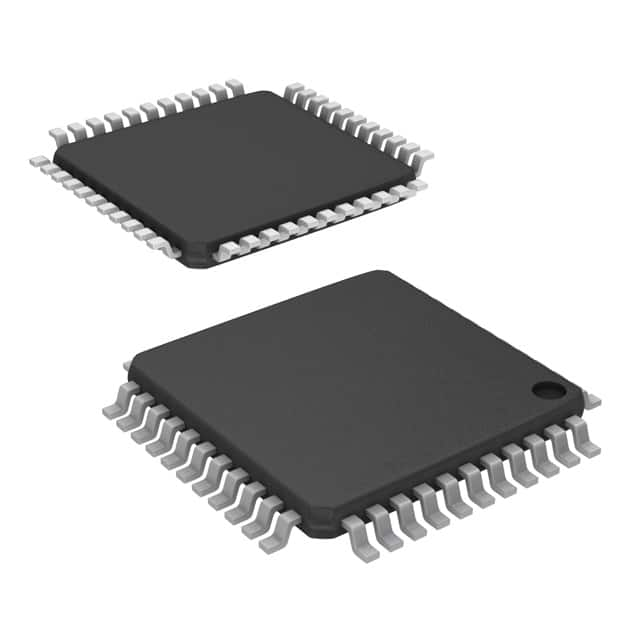Consulte las especificaciones para obtener detalles del producto.

DSPIC33FJ32GP104T-I/PT
Introduction
The DSPIC33FJ32GP104T-I/PT belongs to the category of digital signal controllers (DSCs) and is designed for use in a wide range of applications that require high-performance digital signal processing. This entry provides an overview of the basic information, specifications, pin configuration, functional features, advantages and disadvantages, working principles, application field plans, and alternative models of the DSPIC33FJ32GP104T-I/PT.
Basic Information Overview
- Category: Digital Signal Controllers (DSCs)
- Use: High-performance digital signal processing applications
- Characteristics: High-speed operation, integrated peripherals, enhanced computational capabilities
- Package: TQFP-44
- Essence: Advanced digital signal processing and control
- Packaging/Quantity: Tape & Reel, 250 units per reel
Specifications
- Core: dsPIC33F
- CPU Speed: Up to 40 MIPS
- Program Memory Size: 32 KB Flash
- RAM Size: 4 KB
- Operating Voltage Range: 2.5V to 5.5V
- Digital I/O Pins: 35
- Analog Input Channels: 12
- Communication Interfaces: UART, SPI, I2C
- Timers: 3 x 16-bit, 2 x 32-bit
- Comparators: 2
- ADC Resolution: 10-bit
Detailed Pin Configuration
The DSPIC33FJ32GP104T-I/PT features a TQFP-44 package with specific pin assignments for various functions including digital I/O, analog inputs, communication interfaces, timers, and power supply connections. A detailed pinout diagram is available in the datasheet for precise configuration and connection details.
Functional Features
- High-Speed Operation: The DSC operates at speeds of up to 40 MIPS, enabling rapid signal processing.
- Integrated Peripherals: Integrated ADC, DAC, PWM modules, and communication interfaces streamline system design and reduce external component count.
- Enhanced Computational Capabilities: Advanced DSP engine and math accelerators facilitate complex algorithm execution and control tasks.
Advantages and Disadvantages
Advantages
- High computational performance
- Integrated peripherals reduce external component count
- Wide operating voltage range allows flexibility in system design
Disadvantages
- Limited program memory size may be insufficient for certain applications
- TQFP package may require careful PCB layout for optimal performance
Working Principles
The DSPIC33FJ32GP104T-I/PT operates on the principle of executing digital signal processing algorithms and control tasks using its integrated DSP engine and peripherals. It processes input signals, performs computations, and generates output signals based on programmed instructions, enabling precise control and signal manipulation.
Detailed Application Field Plans
The DSPIC33FJ32GP104T-I/PT finds extensive application in various fields including: - Motor Control: Precise control of motor speed and position in industrial automation and robotics. - Power Conversion: Efficient power conversion and management in renewable energy systems and power electronics. - Audio Processing: High-fidelity audio signal processing in consumer electronics and professional audio equipment.
Detailed and Complete Alternative Models
- DSPIC33FJ32GP102T-I/PT: Similar features with reduced program memory size.
- DSPIC33FJ64GP104T-I/PT: Higher program memory size and additional peripherals.
- DSPIC33FJ32GP202T-I/PT: Enhanced analog and digital peripheral integration.
In conclusion, the DSPIC33FJ32GP104T-I/PT offers high-performance digital signal processing capabilities with integrated peripherals, making it suitable for a wide range of applications. Its advanced features and flexible operating characteristics make it a compelling choice for demanding control and signal processing tasks.
Word Count: 536
Enumere 10 preguntas y respuestas comunes relacionadas con la aplicación de DSPIC33FJ32GP104T-I/PT en soluciones técnicas
Question: What are the key features of DSPIC33FJ32GP104T-I/PT?
Answer: The DSPIC33FJ32GP104T-I/PT features a high-performance 16-bit microcontroller core, integrated peripherals, and extensive connectivity options.Question: How can I interface external sensors with DSPIC33FJ32GP104T-I/PT?
Answer: You can use the built-in analog-to-digital converters (ADC) and digital I/O ports to interface external sensors with the DSPIC33FJ32GP104T-I/PT.Question: What development tools are available for programming DSPIC33FJ32GP104T-I/PT?
Answer: Development tools such as MPLAB X IDE and MPLAB XC16 Compiler are commonly used for programming and debugging DSPIC33FJ32GP104T-I/PT.Question: Can DSPIC33FJ32GP104T-I/PT be used in motor control applications?
Answer: Yes, DSPIC33FJ32GP104T-I/PT is well-suited for motor control applications due to its advanced PWM modules and motor control peripherals.Question: How can I implement communication protocols with DSPIC33FJ32GP104T-I/PT?
Answer: DSPIC33FJ32GP104T-I/PT supports various communication protocols such as UART, SPI, I2C, and CAN, allowing for seamless integration into communication systems.Question: What are the power requirements for DSPIC33FJ32GP104T-I/PT?
Answer: The operating voltage range for DSPIC33FJ32GP104T-I/PT is typically 2.5V to 5.5V, making it suitable for a wide range of power supply configurations.Question: Is DSPIC33FJ32GP104T-I/PT suitable for real-time signal processing?
Answer: Yes, DSPIC33FJ32GP104T-I/PT's high-speed core and dedicated DSP instructions make it ideal for real-time signal processing applications.Question: Can DSPIC33FJ32GP104T-I/PT be used in low-power applications?
Answer: Yes, DSPIC33FJ32GP104T-I/PT offers low-power modes and features to optimize power consumption for battery-operated or energy-efficient designs.Question: Are there any application notes or reference designs available for DSPIC33FJ32GP104T-I/PT?
Answer: Yes, Microchip provides a wealth of application notes, reference designs, and technical documentation to assist in implementing DSPIC33FJ32GP104T-I/PT in various applications.Question: What are the available memory options for DSPIC33FJ32GP104T-I/PT?
Answer: DSPIC33FJ32GP104T-I/PT offers flash program memory, SRAM data memory, and EEPROM data memory, providing flexibility for storing program code and data.

